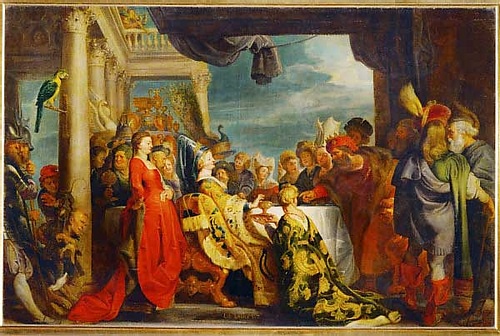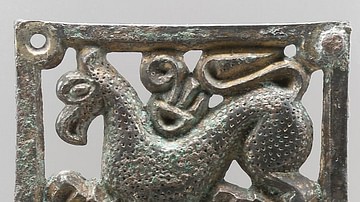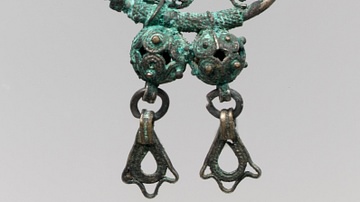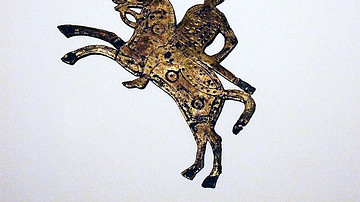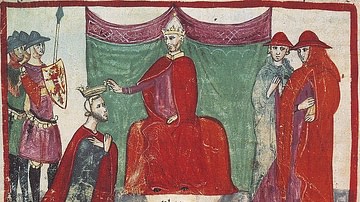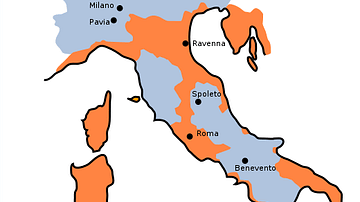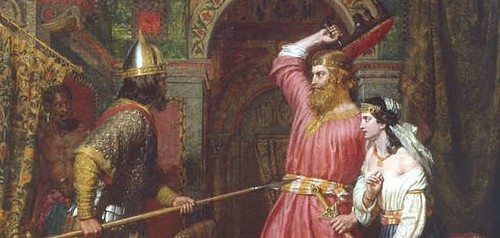
Alboin (r. 560-572 CE) was a king of the Lombards who led his people into Italy and founded the Kingdom of the Lombards which lasted from 568-774 CE. His father was Audoin, King of the Lombards, and his mother Queen Rodelinda.
He was most likely born c. 530 CE in Pannonia, grew up with military training, and fought against the Avar and Gepid tribes before leading his people to Italy. After his first wife, Chlothsind, died, he married Rosamund, the daughter of the Gepid king Cunimund whom Alboin killed in battle. In spite of his military victories and successful reign, he came to be known to later generations primarily through his assassination by his wife, which formed the basis of paintings by a number of artists and works such as the opera Rosamunda by Giovanni Rucellai (1525 CE) and the verse drama Rosamund by Algernon Charles Swinburne (1860 CE).
Both of these artists drew heavily from the primary work on Alboin: Paul the Deacon's 8th-century CE History of the Lombards. Paul records that, in 572 CE, after Alboin had ruled Italy for almost four years, Rosamund had him assassinated to avenge her father's murder. The dramatic nature of the assassination and Alboin's treatment of Rosamund in their marriage has lent itself to imaginative works in which either Alboin or Rosamund is depicted as a tragic figure who suffers unjustly. According to the primary sources, however (especially that of Paul the Deacon), Alboin was a tribal warlord who established a homeland for his people and treated his captive wife as he would any other war prize; he paid for such unkind treatment with his life.
Military Victories & Reign in Pannonia
Nothing is known of Alboin's early years or upbringing. His later exploits suggest that he had military training and, as the son of the king, was most likely instructed in politics. Paul the Deacon first records that he succeeded his father, Audoin, in 560 CE. Audoin had allied himself with the Byzantine Empire, but either he or Alboin decided to broaden their power base by also allying themselves with the Franks, who were then growing in power. C. 560 CE, therefore, Alboin married the daughter of the Frankish king Chlothar, Chlothsind, to secure this alliance. The historian Francesco Borri writes:
Alboin must have been a very powerful man, even if contemporary sources describing his political and military activities are scanty...The fact that Alboin was able to marry a Frankish princess, which no Lombard king after him was able to do, confirms his importance in the scenario of late Roman Europe. (223-224)
The Lombards may have been invited into Pannonia by the Byzantine Empire to deal with the threat of the Gepid tribes in the region or may have come on their own. Either way, conflicts between the Lombards and the Gepids were routine, and the Lombards allied themselves with another tribe, the Avars, to finally crush the Gepids. The Avars had also come to Pannonia either by the invitation of Emperor Justin II or on their own initiative. The Avar king Bayan I (r. 562/565-602 CE) brokered a deal with Alboin agreeing that, if their alliance defeated the Gepids, the Avars would be given the Gepid's lands.
According to Paul the Deacon, in 567 CE the Gepids, now under the rule of their king Cunimund, attacked the Lombards (though other sources claim Alboin and Bayan I instigated hostilities). The precise dates of the alliances between the Byzantine Empire, the Lombards, the Avars, and the Gepids are confused owing to constant contradictions in the primary sources, but it appears that, at this time, the Lombards and Avars were closely allied against the Gepids with the support of the Byzantine Empire.
The alliance crushed the Gepids, and Alboin killed Cunimund by beheading him in battle. He took the head of the king as a trophy and later had it made into a wine cup which he wore on his belt. Other sources, however, claim it was Bayan I who killed Cunimund, beheaded him, and gave the skull to Alboin to celebrate their joint victory.
With the Gepids defeated, Alboin consolidated his rule and marked the boundaries of his territory. The Avars, however, had managed to occupy more of the region than the Gepids had before them, owing to the deal Alboin had agreed to before battle, and they threatened the Lombard territories. Alboin then married Rosamund, daughter of Cunimund, to form an alliance with the Gepids against the Avars, but it was too late.
The Avars under Bayan I were too powerful now, and the Gepid forces were too weakened by the previous war to prove very useful. Alboin realized the most prudent course of action was to leave Pannonia, but he was uncertain where to lead his people to. A large number of Lombard troops had served in the imperial forces under the Byzantine general Narses in Italy, performing particularly well in combat at the Battle of Taginae in 552 CE where Narses defeated the Ostrogothic king Totila and reclaimed Italy for the empire. These soldiers still remembered Italy as a fertile land, and either they suggested a migration to Alboin or, according to other sources, Narses himself invited them to Italy (this later claim is routinely contested). Whatever his motivation, in April 568 CE, Alboin led the Lombards out of Pannonia and into northern Italy.
Migration to Italy & Reign
The Byzantine Empire was at war with the Ostrogoths of Italy since the death of Theodoric the Great in 526 CE until Narses' victory over the Goths at the Battle of Mons Lactarius in 555 CE. In 568 CE, Italy was therefore a part of the Byzantine Empire but was sparsely fortified or defended. So many resources had been expended in winning it back from the Goths over so many years that now the empire seemed confident, for some reason, that the region could defend itself if need be. Alboin and his people entered Italy from the north and took the town of Forum Iulii without a fight.
From here, he marched on Aquileia and, with that town secure, continued his conquest of the region until, by 569 CE, he had taken Milan and controlled the north of Italy without engaging in any serious military conflicts. Between 569-572 CE, Alboin conquered most of the rest of the country (though some parts were still controlled by the Byzantine Empire, such as Rome), establishing his capital at Verona while he lay siege to Pavia, the only city that resisted the Lombard invasion to any significant degree. It took three years of siege to take the city and, while that was in progress, Alboin set about establishing his kingdom from his palace at Verona.
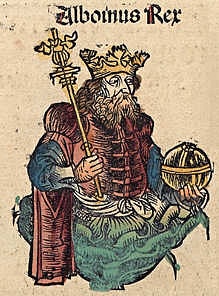
He divided the country into 36 territories known as "duchies," presided over by a duke who was responsible for reporting directly to the king. While this made for efficient government from a bureaucratic point of view, it left too much power in the hands of the individual dukes, and so regions either prospered or suffered depending on the quality of their particular duke.
Alboin ruled effectively from Verona but, as he was more concerned with securing his borders against the Franks and fending off the eastern empire's efforts to dislodge him, he left the affairs of government to these subordinates, which resulted in a lack of cohesion between the territories as each duke, naturally, wanted the best for his particular region. These dukes, therefore, acted autonomously in conquering regions towards the south of Italy which, scholars claim, Alboin had no interest in taking from the Byzantine Empire.
The sources on Alboin's reign are few. Paul the Deacon writes how under Alboin's reign,
There was this wonderful kingdom of the Lombards. There was no violence, no plotting pitfalls, and no others unjustly oppressed. No one plundered and there were no thefts, there was no robbery; everyone went wherever they wanted, safe and without any fear. (History, III, 16)
Although this description is considered by scholars to be an exaggeration, it does seem that Alboin's reign brought stability and prosperity to Italy, especially in the north, and he was an effective monarch in spite of the activities of the individual dukes. Although they acted in their own best interests, historians surmise (based on the general reaction to Alboin's death and the aftermath) that they seem to have believed they were pursuing a course Alboin would have approved of.
Assassination & Aftermath
Alboin's marriage to Rosamund had never been a happy one. Paul the Deacon claims that Alboin routinely abused his wife and mocked her. The marriage, like many involving nobility through the ages, had been simply a device to secure an alliance. Further, Rosamund was already Alboin's captive after the defeat and death of Cunimund, and so she hardly had a choice in marrying the Lombard king. In June 572 CE, she apparently reached the point where she could no longer tolerate being married to the man who had killed her father and wore his skull on his belt as a drinking cup. Paul writes:
When he [Alboin] was more flown with wine than was appropriate at a feast in Verona, he asked that wine be given to the queen to drink in the cup which he had made from the head of his father-in-law Cunimundus. He invited her to drink happily with her father...Therefore, when Rosamund found out about the matter, she conceived a deep pain in her heart that she was unable to quell. She burned to avenge the death of her father on her husband. (History, III, 18)
Rosamund convinced Alboin's foster brother, Helmechis, to murder him. Other sources on Alboin's assassination (such as Gregory of Tours or Marius of Aventicum) provide different details, but all agree that the plot was set in motion by Rosamund who had, perhaps, fallen in love with Helmechis or, at least, was having an affair with him. Rosamund and Helmechis enlisted the aid of a bodyguard named Peredeo, who was tricked into the conspiracy by Rosamund who disguised herself as a servant, had sex with him, and then essentially blackmailed him into service. One day, when Alboin had retired to his room to rest after lunch, Helmechis and Peredeo attacked him. Rosamund had ordered that Peredeo tie Alboin's sword to his bed so the king would be unarmed. Alboin fought off his assailants with a footstool but was beaten down and killed.
The couple, along with Alboin's daughter from his first marriage, Peredeo, the royal treasure, and a segment of the army, then fled from Verona to the Byzantine-controlled city of Ravenna. This course of action has suggested to many historians that the assassination was actually instigated by the Byzantine Empire and Rosamund was manipulated by them.
While the empire may have had a hand in Alboin's death (and certainly would have been relieved by it), the primary sources all claim the assassination was planned and carried out by Rosamund to avenge her father's death and punish her husband for his abuse of her. Even so, the fact that the conspirators were welcomed in Ravenna and that, after their deaths, the royal treasure and Alboin's daughter were sent to Constantinople, does argue in favor of Byzantine involvement in Alboin's assassination.
Helmechis and Rosamund were married in Ravenna, and he proclaimed himself king. The dukes refused to acknowledge him, however, and proclaimed their own king, Cleph, the duke of Pavia, which city had finally fallen to the siege. Rosamund, apparently, did not find Helmechis any more to her liking than she had Alboin and poisoned his wine cup. Helmechis, however, suspecting her treachery, made her drink from the cup either before, or just after, he had done so, and in this way, they both died at the other's hands.
Conclusion
Cleph reigned for 18 months before he was assassinated by one of his servants. The individual dukes then fought each other for control of the kingdom from 572-586 CE, when King Authari was elected in order to fight off incursions by the Byzantines and the Franks. The Lombard Kingdom in Italy maintained its control of the region, sometimes losing and sometimes substantially gaining territory, until 774 CE, when they were conquered by Charlemagne of the Franks and absorbed into his empire.
Although later Lombard kings, such as Agilulf (r. 590-616 CE), Rothari (r. 636-652 CE) and, especially, Liutprand (r. 712-744 CE), made greater advancements in conquest and government than Alboin, the first Lombard king of Italy is still remembered for leading his people to a secure homeland and establishing a kingdom he felt they could call their own. His life and achievements have been overshadowed by his death and his subsequent transformation into a character in literary tragedy but, while he lived, he seems to have been a man of considerable power and vision for the future of his people.
